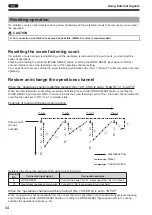
49
EN
Symptoms
Location to investigate
Solution
Stop during the screw
fastening rotation
Aren't burrs, dregs, or particles caught in
the screw hole or screw part?
Check the screw or workpiece.
Is the tapping screw tightened?
It is possible that the setting torque was exceeded
when tightening the screw (before seating).
Check the screw fastening state, and raise the
setting torque.
Have you attached a heavy jig or a jig
having a large radius at the bit tip?
It is possible that the jig inertial force has boosted
the motor current, to attain the setting torque.
Either review the jig (make it lighter, make it
smaller), or boost the setting torque.
Can it be stopped by idling (free rotation
state)?
It is possible that some sort of load can be applied
to the bit area, to boost the motor current, and
attain the setting torque.
Either cancel the load applied to the bit area, or
boost the setting torque.
Is a load applied to the bit area during
screw tightening?
The output torque
is low
Screws cannot be
tightened
Are you correctly combining the measuring
devices for measurement?
In addition, are the types of joint washers
(white rubber, black rubber, metal)
incorporated into screw joints, or the
incorporated sequence, correct?
Use a combination of NITTO KOHKI designated
measuring devices for measurement. (p. 8)
Check whether the screw joints are correct, and
perform measurement. (p. 10)
Has the permanent set in fatigue, cracks,
deformation, and hardening occurred in the
joint washers (white rubber, black rubber,
metal) incorporated into screw joints?
(p. 10)
In cases where changes have occurred in the
rubber, there is a need to replace with new joint
washer parts.
Has the output torque changed?
The output torque changes over time.
Regularly check the output torque, and adjust the
setting torque. (p. 11)
Did you check the correlation between
the output torque occurred on screws
and the output torque measured using a
measurement device?
The output torque occurred on screws and the
output torque measured by the measurement
device are different.
Adjust the output torque according to the screw
fastening conditions. (p. 11)
Are there differences in the screw
fastening operation methods (operator,
force for handling or pressing the electric
screwdriver, fixing method, etc.)?
Torque conveyed to the motor current or screw
changes depending on the operations method.
Perform the screw tightening under fixed
operation conditions.
Is the bit worn out?
When the bit is worn out, it becomes difficult to
convey the torque to screws. Replace the bit.
Are you tightening while crushing a part
between the screws?
Has regression loosening occurred?
Torque may not be transmitted. Crush the part
once and then tighten the screw.
Has axial force occurred to the screw?
Without axial force, even though the output torque
is increased, screws are not tightened. Review the
screw fastening conditions.
Has initial loosening occurred?
Initial loosening occurs as a result of permanent
set in fatigue when fine irregularities such as
surface roughness are lost over time after the
screw is tightened or outside force is applied.
Remove the screw and tighten it again.
Has the permanent set in fatigue occurred
due to permanent deformation of sealing
material such as the gasket?
Carefully check the screw fastening conditions
and set the output torque.
Has the temperature surrounding the
electric screwdriver, screw, or workpiece
changed?
Change in temperature can deform the workpiece,
stretch or loosen the screws, or cause changes in
the electric screwdriver characteristics.
Review the screw fastening conditions and
process.
Are there occurrence or impressions of
vibrations or external force?
Loosening of screw occurs if no measures are
taken for vibration or outside force.
Take appropriate loosening prevention measures,
as necessary.
TV07783-1_DLV10C_en.indb 49
2017/06/27 17:41:42















































